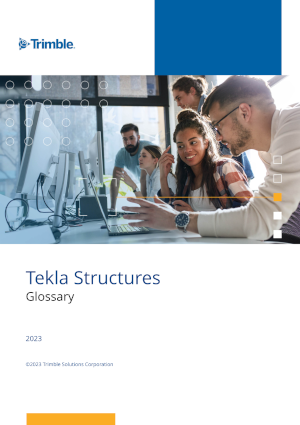
© Trimble Solutions Corporation, 2023
Glossary is available:
- in PDF format
Tekla Structures glossary is a terminological glossary related to the building information modelling software Tekla Structures, and published and maintained by the software company Trimble Solutions (formerly called Tekla). The software and the accompanying glossary contain terminology from both construction and IT fields.
Tekla Structures glossary is a terminological glossary related to the building information modelling software Tekla Structures, and published and maintained by the software company Trimble Solutions (formerly called Tekla). The software and the accompanying glossary contain terminology from both construction and IT fields.
The glossary is targeted especially to technical writers, user interface planners, marketeers, trainers, and software users. The aim of the terminology work is to clarify concepts by means of definitions and to give consistent recommendations on term usage both in the software’s user interface and its accompanying material, such as user assistance and marketing material.
Currently, the glossary comprises 620 concepts related to Tekla Structures, described in English. Relations between concepts are visualised by concept system diagrams. The content of each concept is described by means of a definition and supplementary notes. Usage recommendations are provided for the English terms.
The update cycle of the glossary goes hand in hand with that of the software. In the beginning of 2023, new versions of both Tekla Structures software and the glossary were released. In this update, new concepts were added to the glossary and existing concepts were brought up-to-date.
The cooperation between the Terminology Centre TSK and the then software company Tekla started at the end of 2006. The first version of the Tekla Structures glossary was published in 2009. In earlier update projects, since spring 2010, the glossary has been modified to reflect the software in its different development phases, as well as any new practices adopted in the user interface. These update projects have also taken into account any feedback from glossary users.